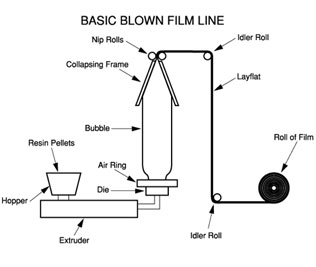Blown Film Extrusion (Film Blowing)
Blown Film Extrusion is an established process which is sued to manufacture a wide range of commodity & specialized plastic films for the packaging industry. Also known as Film Blowing Process, this extrusion process generally comprises extrusion of molten thermoplastic tube and its constant inflation to severaltimes of its initial diameter. This forms a thin, tubular product which may be used directly, or indirectly by slitting it to create a flat film.
 Materials Used Materials Used
In the process of Blown Film Extrusion, the common resins that are used are Polyethylenes (LDPE, HDPE and LLDPE). Though, various other materials can also be used in this process, as a blend with resins or even as single layers in the multi-layer film structure. Some of these materials are PP, PP, and EVOH. In few instances when these materials are not able to gel together, then a multi-layer film might get de-laminate. Hence, to overcome this issue, various tiny layers of special adhesive resins are used purposefully in between. These tiny layers are called “tie layers”.
Process Of Blown Film Extrusion
The extrusion of plastic melt is done via an annular slit die, generally vertically, for the formation of a thin walled tube. The introduction of air takes place through a hole present in the die's center for blowing up the tube just like a balloon. The cooling of the hot film is done by the high-speed air ring that blows onto it. This air ring is mounted on the top of die. Then following procedures take place:
- The tube of the film continues its movement upwards (constantly colling) till is is passed via nip rolls. Here, the tube is flattened for the creation of “lay-flat” tube of film. Also known as collapsed tube, this lay-flat tube goes back to the extrusion tower via rollers.
- On the higher output lines, exchange of air (which is available in the bubble) takes place. This is called IBS (Internal Bubble Cooling).
- Then the lay-flat film is kept as it is or its edges are slit off for producing 2 flat film sheets & wound up onto the reels. If kept as it is, the film's tube is created into bags by the process of sealing all across the film's width along with cutting or perforating. This process is carried out at a later stage or in line with the process of blown film.
Advantages Of Blown Film Extrusion
- In a single operation, flat as well as gusseted tubing are formed
- Regulation of film thickness and width with the control of air volume in the bubble
- Elimination of the end effects like edge bead trim along with non-uniform temperature which can cause from flat die film extrusion
- Capability of biaxial orientation, which allows uniformity in all the mechanical properties
Very high productivity
- Allows combination of different materials as well as properties
Applications Of Blown Film Extrusion
In this extrusion process, the blown film is used either in tube form (for plastic sacks and bags) or a sheet can be used by slitting the tube. Typical applications of the Blown Film Extrusion or Film Blowing includes following:
| Industry Packaging |
Shrink Film
Stretch Film
Bag Film
Container Liners |
| Consumer Packaging |
Packaging Film For Frozen Products
Shrink Film For Transport Packaging
Food Wrap Film
Packaging Bags
Form, Fill And Seal Packaging Film |
| Laminating Film |
Laminating of aluminum or paper used for packaging milk, coffee, and similar products |
| Barrier Film |
Film Made of Raw Materials like Polyamides and EVOH acting as an aroma or oxygen barrier that are used to package food, e.g. cold meats and cheese |
| Agricultural Film |
Greenhouse Film
Crop Forcing Film
Silage Film
Silage Stretch Film |
| Films For Packaging Medical Products |
|
|
|
|